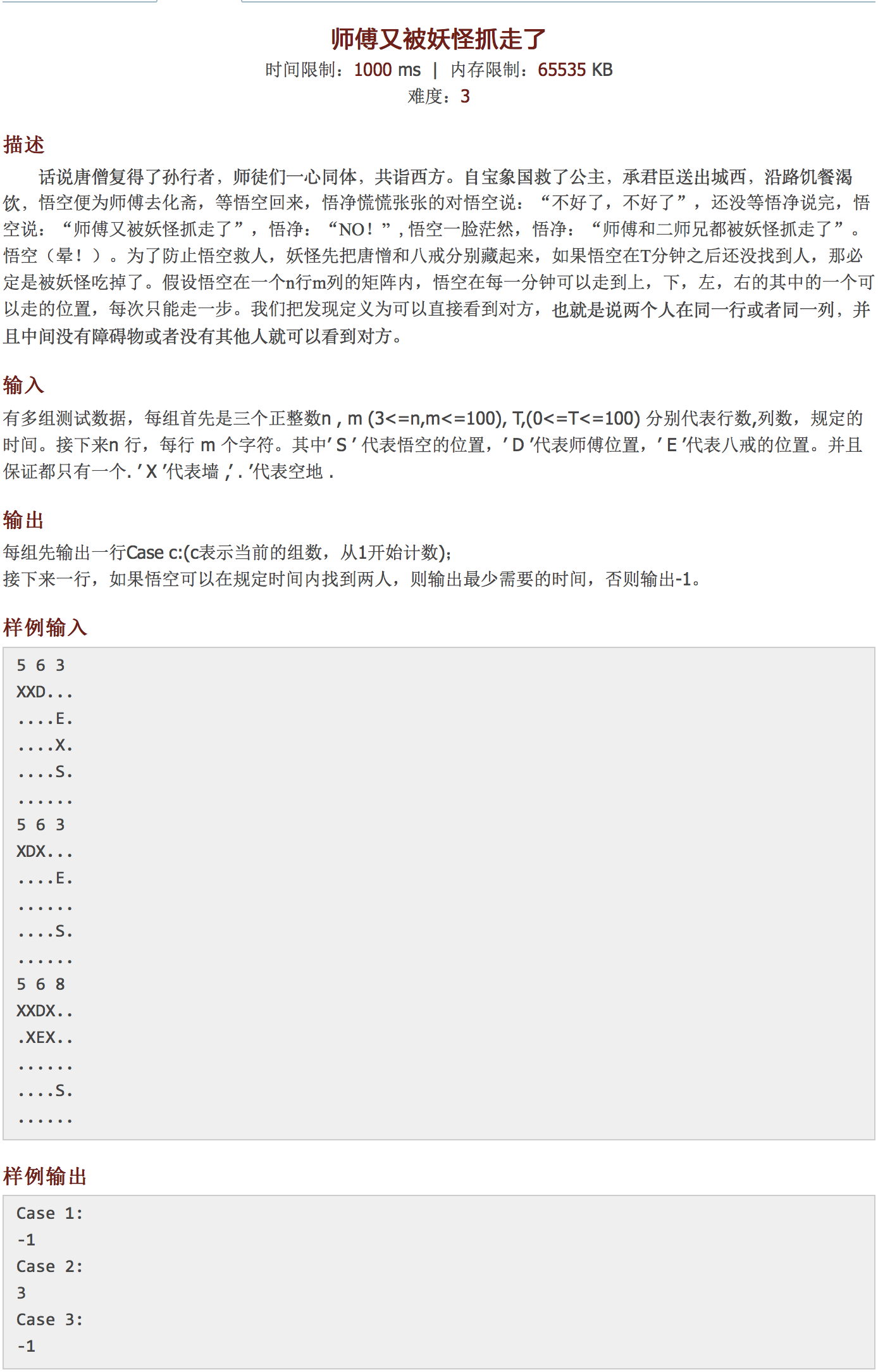描述
题解
第一次做双BFS,有些生疏,有些想当然。一直以为最先搜索出来的就是最优的,可是对于双BFS而言,第一个BFS最先搜索出来的不一定是最优的,需要将第一个BFS搜索出来的所有结果都进行第二个BFS,从得到的答案中选取最优即可。
因为没有写过双BFS,所以一开始写的代码十分冗杂,不够简练,后参考标准的双BFS代码后改写了一下下……
挺不错的一道题,毕竟是我做的第一个双BFS,理解了这个算法的误区后,感觉题也不是那么复杂(事后诸葛亮)。
代码
#include <iostream>
#include <cstdio>
#include <queue>
#include <cstring>
#include <algorithm>
using namespace std;
#define MAXN 105
#define INF 0x3f3f3f3f
typedef struct
{
int x;
int y;
int step;
} path;
char map[MAXN][MAXN];
int n, m, t;
path Path; // 孙猴子起点位置
int ans = INF;
int dir[4][2] = {{-1, 0}, {0, 1}, {1, 0}, {0, -1}};
// 检查是否可以到达
bool check(int x, int y)
{
if (map[x][y] == 'X' || map[x][y] == 'E' || map[x][y] == 'D')
{
return false;
}
return true;
}
// 预处理
char getCharValue(char otype, char type)
{
if ((type == 'D' && otype == 'e') || (type == 'E' && otype == 'd'))
{
return 'b';
}
return type == 'D' ? 'd' : 'e';
}
// 预处理,把能看到D的位置置为d,看到E的位置置为e,能看到两者的置为b
void setMap(int x, int y, char type)
{
int i;
for (i = x + 1; i < n && check(i, y); ++i)
{
map[i][y] = getCharValue(map[i][y], type);
}
for (i = x - 1; i >= 0 && check(i, y); --i)
{
map[i][y] = getCharValue(map[i][y], type);
}
for (i = y + 1; i < m && check(x, i); ++i)
{
map[x][i] = getCharValue(map[x][i], type);
}
for (i = y - 1; i >= 0 && check(x, i); --i)
{
map[x][i] = getCharValue(map[x][i], type);
}
}
// 检查边界
bool isLegal(path p)
{
if (p.x >= 0 && p.y >= 0 && p.x < n && p.y < m)
{
return true;
}
return false;
}
int bfs_(path startp, char type)
{
queue<path> Qu;
bool vis[MAXN][MAXN];
path ptop, ptmp;
memset (vis, false, sizeof(vis));
vis[startp.x][startp.y] = true;
Qu.push(startp);
while (!Qu.empty())
{
ptop = Qu.front();
Qu.pop();
if ((type == 'd' && map[ptop.x][ptop.y] == 'e') || (type == 'e' && map[ptop.x][ptop.y] == 'd'))
{
return ptop.step;
}
for (int i = 0; i < 4; ++i)
{
ptmp.x = ptop.x + dir[i][0];
ptmp.y = ptop.y + dir[i][1];
ptmp.step = ptop.step + 1;
if (isLegal(ptmp) && check(ptmp.x, ptmp.y) && !vis[ptmp.x][ptmp.y] && ptmp.step < ans)
{
vis[ptmp.x][ptmp.y] = true;
Qu.push(ptmp);
}
}
}
return t + 1;
}
void bfs()
{
queue<path> Qu;
path ptop, ptmp;
bool visited[MAXN][MAXN];
ans = INF;
memset(visited, false, sizeof(visited));
Qu.push(Path);
visited[Path.x][Path.y] = true;
while (!Qu.empty())
{
ptop = Qu.front();
Qu.pop();
if (map[ptop.x][ptop.y] == 'b')
{
ans = min(ans, ptop.step);
}
else if (map[ptop.x][ptop.y] == 'e' || map[ptop.x][ptop.y] == 'd')
{
// 找到一个人,调用第二个bfs寻找第二个人
int tmp = bfs_(ptop, map[ptop.x][ptop.y]);
ans = min (ans, tmp);
}
for (int i = 0; i < 4; ++i)
{
ptmp.x = ptop.x + dir[i][0];
ptmp.y = ptop.y + dir[i][1];
ptmp.step = ptop.step + 1;
if (isLegal(ptmp) && check(ptmp.x, ptmp.y) && !visited[ptmp.x][ptmp.y] && ptmp.step < ans)
{
visited[ptmp.x][ptmp.y] = true;
Qu.push(ptmp);
}
}
}
if (ans <= t)
{
printf ("%d\n", ans);
}
else
{
printf ("-1\n");
}
}
int main()
{
int Case = 1;
while (~scanf("%d%d%d", &n, &m, &t))
{
for (int i = 0; i < n; ++i)
{
scanf ("%s", map[i]);
for (int j = 0; j < m; ++j)
{
if (map[i][j] == 'S')
{
Path.x = i, Path.y = j, Path.step = 0;
}
}
}
for (int i = 0; i < n; ++i)
{
for (int j = 0; j < m; ++j)
{
if (map[i][j] == 'E')
{
setMap(i, j, map[i][j]);
}
else if (map[i][j] == 'D')
{
setMap(i, j, map[i][j]);
}
}
}
printf ("Case %d:\n", Case++);
bfs();
}
return 0;
}






















 632
632











 被折叠的 条评论
为什么被折叠?
被折叠的 条评论
为什么被折叠?








